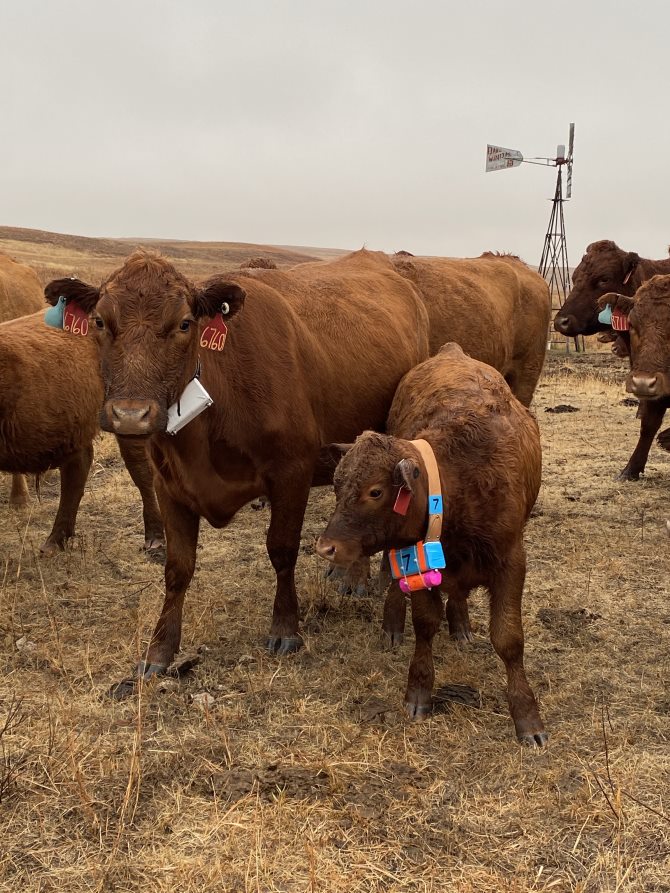
Maximizing the Plains
Newest Precision Innovations of Nebraska Sandhill Ranchers
In the Sandhills of Nebraska, researchers are testing precision agricultural technologies focused on better understanding and managing cattle within extensive rangeland systems.
Tools, such as individual livestock feeders and GPS tracking, help researchers evaluate cattle and rangelands responses under a variety of environmental stress conditions.
Managing stress with specific precision strategies produces more consistent animal husbandry practices, resulting in healthier rangelands and improved cattle performance in these environments, which ultimately will increase long-term sustainability of forage-based livestock systems.
Mitch Stephenson, associate professor in the Department of Agronomy and Horticulture and Travis Mulliniks, associate professor in the Department of Animal Science at the University of Nebraska–Lincoln, conduct precision livestock management (PLM) research at the Gudmundsen Sandhills Laboratory near Whitman, Neb., to test ranching practices that both maintain and improve cattle production and the ecosystems on which they graze.
Precision Rangeland Management
Stress biology is an organism’s response to outside factors. There are various stressors on livestock, but the environmental stress is the most common.
“The number one stress factor for livestock is environmental stress,” Mulliniks said. “This stress could be winter weather, heat, drought, or any low-quality environmental situation.”
Precision rangeland management strategies create solutions for these environmental stressors on rangeland plants.
“Precision rangeland management strategies consist of specific tools that give continuous, typically automatic, real-time monitoring that help in decision making,” Stephenson said.
The precision rangeland management strategies tested provide data-driven solutions and decision-making tools to improve sustainability and profitability of rangeland beef production systems.
Real-time monitoring provides a greater understanding of aspects of production that were initially left to guesswork. For example, Mulliniks and Stephenson can now identify and track the different stressors, like heart rate changes based on different grazing environments and genetics of the cow.
Data collected from GPS tracking sensors suggests when to move cattle to different pastures, what changes to a cattle’s diets are needed, and how to create optimal grazing locations through malleable virtual fences.
Stephenson said that together, the data provides solutions to potential problems linked with overgrazing and poor livestock distribution on rangelands.
Technology in Use
Historically, the health of cattle and their grazing pattern was not measured in real-time, which led to over-grazed pastures potentially causing long-term environmental harm. Real-time data provides faster reaction times, Mulliniks said, and reduces the mitigation of negative animal and range health.
The goal of this projectis to develop data for every step of the animal rearing process to assist the rancher’s decision choices for their animals and land.
“It is important to optimize health and productivity of cattle on ranches,” Mulliniks said. “Nebraska plays an important role in the food system of the United States, and our goal is to increase the long-term sustainability for our ranchers.”
Mulliniks said new devices are currently in development: electronic feeding systems and remote sensors.
Electronic Feeding Systems
The Super Smart Feeder streamlines the feeding process by placing an electronic identification device (EID) on cattle. Mulliniks said through the EID, ranchers can control how much supplement each individual cow and calf receive daily. The EIDs are both access cards to their feeders as well as determine some have the capacity to track where any single cows is in real time with GPS.
Remote Sensors
Drones are already a common sight on ranches, used to check waters and cattle’s general positions.
Stephenson said that remote sensors and GPS collars can help ranchers better map grazing patterns. For example, as a pasture reaches its capacity, ranchers can change the movement of the heard to better distribute cattle across a landscape .
Creation of the Center
Research focused on PLM was started as a result of a multi-state initiative between researchers at the University of Nebraska–Lincoln, Montana State Universityand Oregon State Univestity. Their efforts resulted in a $3 million grant from the U.S. Department of Agriculture.
“We were doing similar research across these three states,” Mulliniks said. “The different locations creates a nice gradient covering the west coast to the Midwest – different environments, different plant communities, different stressors.”
Going Forward
As more technologies become available, the Gudmundsen Laboratory will continue testing new products at commercial scales to gain even more information to producers in the area on better ways to manage their livestock and rangelands using PLM, according to Stephenson.
“The Gudmundsen Laboratory is managed in a way to be similar to other ranches in the area,” Stephenson said. “As a research facility goes, it is a premier research facility in the Western United States.”
For more information, check out their monthly beef watch article at https://beef.unl.edu/beefwatch/archive & the bi-annual Gudmundsen Sandhills Laboratory Newsletter at https://extension.unl.edu/statewide/westcentral/gsl-newsletter/.
Key Takeaways:
- Researchers are testing precision agricultural technologies focused on better understanding and managing cattle within extensive rangeland systems, particularly those areas that are deemed as high stress.
- Tools, such as individual livestock feeders and GPS tracking, help researchers evaluate cattle and rangelands responses under a variety of environmental stress conditions.
- Managing stress with specific precision strategies produces more consistent animal husbandry practices, resulting in healthier rangelands and improved cattle performance in these environments, which ultimately will increase long-term sustainability of forage-based livestock systems.
- The precision rangeland management strategies tested provide data-driven solutions and decision-making tools to improve sustainability and profitability of rangeland beef production systems.
5. For more information, check out their monthly beef watch article at https://beef.unl.edu/beefwatch/archive & the bi-annual Gudmundsen Sandhills Laboratory Newsletter at https://extension.unl.edu/statewide/westcentral/gsl-newsletter/.
